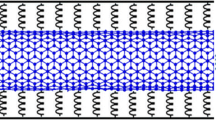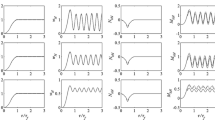Abstract
In this article, the influences of rotational speed and velocity of viscous fluid flow on free vibration behavior of spinning single-walled carbon nanotubes (SWCNTs) are investigated using the modified couple stress theory (MCST). Taking attention to the first-order shear deformation theory, the modeled rotating SWCNT and its equations of motion are derived using Hamilton’s principle. The formulations include Coriolis, centrifugal and initial hoop tension effects due to rotation of the SWCNT. This system is conveying viscous fluid, and the related force is calculated by modified Navier–Stokes relation considering slip boundary condition and Knudsen number. The accuracy of the presented model is validated with some cases in the literatures. Novelty of this study is considering the effects of spinning, conveying viscous flow and MCST in addition to considering the various boundary conditions of the SWCNT. Generalized differential quadrature method is used to approximately discretize the model and to approximate the equations of motion. Then, influence of material length scale parameter, velocity of viscous fluid flow, angular velocity, length, length-to-radius ratio, radius-to-thickness ratio and boundary conditions on critical speed, critical velocity and natural frequency of the rotating SWCNT conveying viscous fluid flow are investigated.


























Similar content being viewed by others
References
Abbasnejad B, Shabani R, Rezazadeh G (2015) Stability analysis of a piezoelectrically actuated micro-pipe conveying fluid. Microfluid Nanofluid 19:577–584
Alibeigloo A, Shaban M (2013) Free vibration analysis of carbon nanotubes by using three-dimensional theory of elasticity. Acta Mech 224:1415–1427
Ansari R, Norouzzadeh A, Gholami R, Shojaei MF, Hosseinzadeh M (2014) Size-dependent nonlinear vibration and instability of embedded fluid-conveying SWBNNTs in thermal environment. Phys E 61:148–157
Ansari R, Gholami R, Norouzzadeh A (2016a) Size-dependent thermo-mechanical vibration and instability of conveying fluid functionally graded nanoshells based on Mindlin’s strain gradient theory. Thin-Walled Struct 105:172–184
Ansari R, Norouzzadeh A, Gholami R, Shojaei MF, Darabi M (2016b) Geometrically nonlinear free vibration and instability of fluid-conveying nanoscale pipes including surface stress effects. Microfluid Nanofluid 20:1–14
Arani AG, Hashemian M, Kolahchi R (2013) Time discretization effect on the nonlinear vibration of embedded SWBNNT conveying viscous fluid. Compos B Eng 54:298–306
Arani AG, Kolahchi R, Hashemian M (2014) Nonlocal surface piezoelasticity theory for dynamic stability of double-walled boron nitride nanotube conveying viscose fluid based on different theories. Proc Inst Mech Eng C J Mech Eng Sci 228:3258–3280
Asghari M, Kahrobaiyan M, Rahaeifard M, Ahmadian M (2011) Investigation of the size effects in Timoshenko beams based on the couple stress theory. Arch Appl Mech 81:863–874
Bahaadini R, Hosseini M (2016) Effects of nonlocal elasticity and slip condition on vibration and stability analysis of viscoelastic cantilever carbon nanotubes conveying fluid. Comput Mater Sci 114:151–159
Bellman R, Casti J (1971) Differential quadrature and long-term integration. J Math Anal Appl 34:235–238
Bellman R, Kashef B, Casti J (1972) Differential quadrature: a technique for the rapid solution of nonlinear partial differential equations. J Comput Phys 10:40–52
Beni YT, Mehralian F, Razavi H (2015) Free vibration analysis of size-dependent shear deformable functionally graded cylindrical shell on the basis of modified couple stress theory. Compos Struct 120:65–78
Civalek Ö (2004) Application of differential quadrature (DQ) and harmonic differential quadrature (HDQ) for buckling analysis of thin isotropic plates and elastic columns. Eng Struct 26:171–186
Eftekhari M, Mohammadi S, Khoei AR (2013) Effect of defects on the local shell buckling and post-buckling behavior of single and multi-walled carbon nanotubes. Comput Mater Sci 79:736–744
Elishakoff I, Pentaras D (2009) Fundamental natural frequencies of double-walled carbon nanotubes. J Sound Vib 322:652–664
Fereidoon A, Andalib E, Mirafzal A (2016) Nonlinear vibration of viscoelastic embedded-DWCNTs integrated with piezoelectric layers-conveying viscous fluid considering surface effects. Phys E 81:205–218
Firouz-Abadi R, Torkaman-Asadi M, Rahmanian M (2013) Whirling frequencies of thin spinning cylindrical shells surrounded by an elastic foundation. Acta Mech 224:881–892
Ghadiri M, Safarpour H (2016) Free vibration analysis of embedded magneto-electro-thermo-elastic cylindrical nanoshell based on the modified couple stress theory. Appl Phys A 122:833
Ghadiri M, SafarPour H (2017) Free vibration analysis of size-dependent functionally graded porous cylindrical microshells in thermal environment. J Therm Stresses 40:55–71
Ghadiri M, Shafiei N, Safarpour H (2016) Influence of surface effects on vibration behavior of a rotary functionally graded nanobeam based on Eringen’s nonlocal elasticity. Microsyst Technol 1–21. doi:10.1007/s00542-016-2822-6
Hosseini M, Bahaadini R (2016) Size dependent stability analysis of cantilever micro-pipes conveying fluid based on modified strain gradient theory. Int J Eng Sci 101:1–13
Hosseini-Hashemi S, Ilkhani M, Fadaee M (2013) Accurate natural frequencies and critical speeds of a rotating functionally graded moderately thick cylindrical shell. Int J Mech Sci 76:9–20
Hu K, Wang Y, Dai H, Wang L, Qian Q (2016) Nonlinear and chaotic vibrations of cantilevered micropipes conveying fluid based on modified couple stress theory. Int J Eng Sci 105:93–107
Hua L, Lam K (1998) Frequency characteristics of a thin rotating cylindrical shell using the generalized differential quadrature method. Int J Mech Sci 40:443–459
Hummer G, Rasaiah JC, Noworyta JP (2001) Water conduction through the hydrophobic channel of a carbon nanotube. Nature 414:188–190
Kolter W (1964) Couple stresses in the theory of elasticity. In: Proceedings Koninklijke Nederlandse Akademie van Wetenschappen, vol 67
Kuang Y, He X, Chen C, Li G (2009) Analysis of nonlinear vibrations of double-walled carbon nanotubes conveying fluid. Comput Mater Sci 45:875–880
Lee H-L, Chang W-J (2008) Free transverse vibration of the fluid-conveying single-walled carbon nanotube using nonlocal elastic theory. J Appl Phys 103:024302
Li C, Chen L, Shen J (2015) Vibrational responses of micro/nanoscale beams: size-dependent nonlocal model analysis and comparisons. J Mech 31:7–19
Li L, Hu Y, Li X, Ling L (2016) Size-dependent effects on critical flow velocity of fluid-conveying microtubes via nonlocal strain gradient theory. Microfluid Nanofluid 20:1–12
Liew K, Ng T, Zhao X, Reddy J (2002) Harmonic reproducing kernel particle method for free vibration analysis of rotating cylindrical shells. Comput Methods Appl Mech Eng 191:4141–4157
Maraghi ZK, Arani AG, Kolahchi R, Amir S, Bagheri M (2013) Nonlocal vibration and instability of embedded DWBNNT conveying viscose fluid. Compos B Eng 45:423–432
Miandoab EM, Pishkenari HN, Yousefi-Koma A, Hoorzad H (2014) Polysilicon nano-beam model based on modified couple stress and Eringen’s nonlocal elasticity theories. Phys E 63:223–228
Mindlin RD (1951) Influence of rotary inertia and shear on flexural motions of isotropic elastic plates. Trans ASME 18:31–38
Mindlin RD (1964) Micro-structure in linear elasticity. Arch Ration Mech Anal 16:51–78
Mirramezani M, Mirdamadi HR (2012a) Effects of nonlocal elasticity and Knudsen number on fluid–structure interaction in carbon nanotube conveying fluid. Phys E 44:2005–2015
Mirramezani M, Mirdamadi HR (2012b) The effects of Knudsen-dependent flow velocity on vibrations of a nano-pipe conveying fluid. Arch Appl Mech 82:879–890
Natsuki T, Ni Q-Q, Endo M (2007) Wave propagation in single-and double-walled carbon nanotubes filled with fluids. J Appl Phys 101:034319
Paidoussis M, Denise J-P (1972) Flutter of thin cylindrical shells conveying fluid. J Sound Vib 20:9–26
Park S, Gao X (2006) Bernoulli–Euler beam model based on a modified couple stress theory. J Micromech Microeng 16:2355
Rabani Bidgoli M, Saeed Karimi M, Ghorbanpour Arani A (2016) Nonlinear vibration and instability analysis of functionally graded CNT-reinforced cylindrical shells conveying viscous fluid resting on orthotropic Pasternak medium. Mech Adv Mater Struct 23:819–831
Rafiei M, Mohebpour SR, Daneshmand F (2012) Small-scale effect on the vibration of non-uniform carbon nanotubes conveying fluid and embedded in viscoelastic medium. Phys E 44:1372–1379
Rao C, Cheetham A (2001) Science and technology of nanomaterials: current status and future prospects. J Mater Chem 11:2887–2894
Reddy J (2011) Microstructure-dependent couple stress theories of functionally graded beams. J Mech Phys Solids 59:2382–2399
Reissner E (1945) The effect of transverse shear deformation on the bending of elastic plates. Trans ASME 12:69–77
Setoodeh A, Afrahim S (2014) Nonlinear dynamic analysis of FG micro-pipes conveying fluid based on strain gradient theory. Compos Struct 116:128–135
Shaat M, Mahmoud F, Gao X-L, Faheem AF (2014) Size-dependent bending analysis of Kirchhoff nano-plates based on a modified couple-stress theory including surface effects. Int J Mech Sci 79:31–37
Shu C (2012) Differential quadrature and its application in engineering. Springer Science & Business Media, Berlin
Shu C, Richards BE (1992) Application of generalized differential quadrature to solve two-dimensional incompressible Navier–Stokes equations. Int J Numer Methods Fluids 15:791–798
Tadi Beni Y, Mehralian F, Zeighampour H (2016) The modified couple stress functionally graded cylindrical thin shell formulation. Mech Adv Mater Struct 23:791–801
Tang M, Ni Q, Wang L, Luo Y, Wang Y (2014) Nonlinear modeling and size-dependent vibration analysis of curved microtubes conveying fluid based on modified couple stress theory. Int J Eng Sci 84:1–10
Tauchert TR (1974) Energy principles in structural mechanics. McGraw-Hill Companies, New York
Torkaman-Asadi M, Rahmanian M, Firouz-Abadi R (2015) Free vibrations and stability of high-speed rotating carbon nanotubes partially resting on Winkler foundations. Compos Struct 126:52–61
Toupin RA (1962) Elastic materials with couple-stresses. Arch Ration Mech Anal 11:385–414
Tu Q, Yang Q, Wang H, Li S (2016) Rotating carbon nanotube membrane filter for water desalination. Sci Rep 6. doi:10.1038/srep26183
Wang L (2010) Size-dependent vibration characteristics of fluid-conveying microtubes. J Fluids Struct 26:675–684
Wang L, Liu H, Ni Q, Wu Y (2013) Flexural vibrations of microscale pipes conveying fluid by considering the size effects of micro-flow and micro-structure. Int J Eng Sci 71:92–101
Wang L, Hong Y, Dai H, Ni Q (2016) Natural frequency and stability tuning of cantilevered CNTs conveying fluid in magnetic field. Acta Mech Solida Sin 29:567–576
Yang F, Chong A, Lam D, Tong P (2002) Couple stress based strain gradient theory for elasticity. Int J Solids Struct 39:2731–2743
Yang Z, Nakajima M, Shen Y, Fukuda T (2011) Nano-gyroscope assembly using carbon nanotube based on nanorobotic manipulation. In: 2011 International symposium on micro-nanomechatronics and human science (MHS), pp 309–314
Yoon J, Ru C, Mioduchowski A (2005) Vibration and instability of carbon nanotubes conveying fluid. Compos Sci Technol 65:1326–1336
Yoon J, Ru C, Mioduchowski A (2006) Flow-induced flutter instability of cantilever carbon nanotubes. Int J Solids Struct 43:3337–3349
Zeighampour H, Beni YT (2014) Size-dependent vibration of fluid-conveying double-walled carbon nanotubes using couple stress shell theory. Phys E 61:28–39
Zhang Z, Liu Y, Li B (2014) Free vibration analysis of fluid-conveying carbon nanotube via wave method. Acta Mech Solida Sin 27:626–634
Zhang Z, Liu Y, Zhao H, Liu W (2016) Acoustic nanowave absorption through clustered carbon nanotubes conveying fluid. Acta Mech Solida Sin 29:257–270
Zhen Y-X, Fang B (2015) Nonlinear vibration of fluid-conveying single-walled carbon nanotubes under harmonic excitation. Int J Non-Linear Mech 76:48–55
Zidour M, Benrahou KH, Semmah A, Naceri M, Belhadj HA, Bakhti K et al (2012) The thermal effect on vibration of zigzag single walled carbon nanotubes using nonlocal Timoshenko beam theory. Comput Mater Sci 51:252–260
Author information
Authors and Affiliations
Corresponding author
Appendix
Appendix
Rights and permissions
About this article
Cite this article
SafarPour, H., Ghadiri, M. Critical rotational speed, critical velocity of fluid flow and free vibration analysis of a spinning SWCNT conveying viscous fluid. Microfluid Nanofluid 21, 22 (2017). https://doi.org/10.1007/s10404-017-1858-y
Received:
Accepted:
Published:
DOI: https://doi.org/10.1007/s10404-017-1858-y




